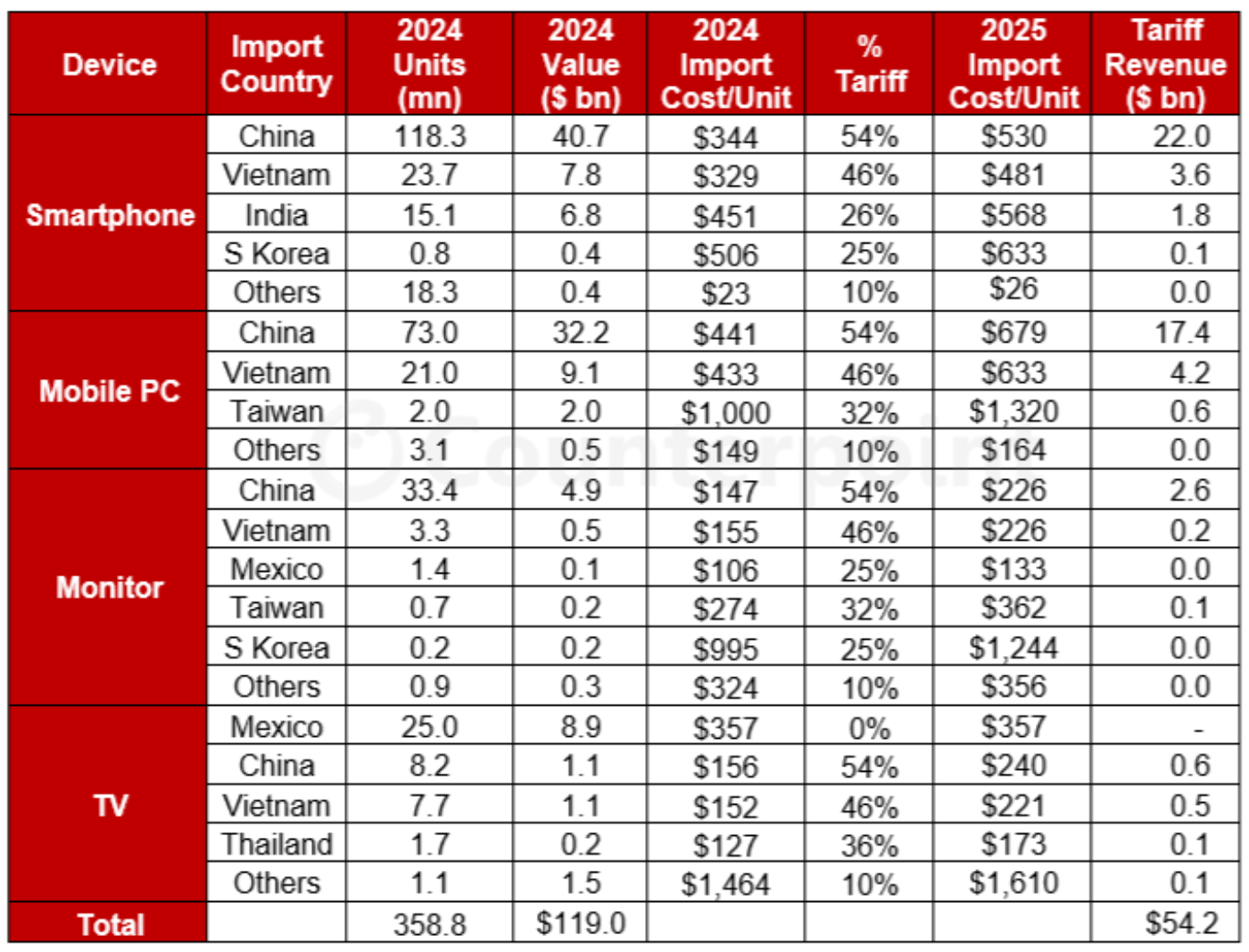[新着] トランプ関税、FPD産業に大打撃へ
これらCounterpoint Research FPD部門 (旧DSCC) 発の分析記事をいち早く無料配信するメールマガジンにぜひご登録ください。ご登録者様ならではの優先特典もご用意しています。【簡単ご登録は こちらから 】
トランプ関税、FPD産業に大打撃へ
ドナルド・トランプ米大統領が4月2日、米国内ディスプレイ (以下FPD) 製品の大幅値上げをもたらす一連の全面的関税措置を発表した。トランプ大統領が発表した「米国の貿易赤字に大きくかつ恒常的に寄与する貿易慣行を是正するための相互関税による輸入規制」と題する大統領令は、80年にわたる米国の貿易政策を覆し、関税制度を19世紀当時に戻すものとなる。
大統領令は、この動きを正当化するための長いセクションから始まる。米国と他国との貿易における不均衡と、それが米国の製造業に与えたダメージについて概説している。米国の2024年の貿易赤字は商品で1兆2000億ドルという過去最大を記録した。そして、最初の実質的な条項で、トランプ大統領は米国の貿易赤字に関する国家非常事態を宣言、以下をその理由として挙げている。
- 製造業の雇用が失われ、製造能力が低下し、防衛産業部門を含む産業基盤が萎縮する事態につながっている。
- 貿易赤字がサプライチェーンの混乱に対する米国経済の回復力を低下させることにより、米国の経済と国家の安全保障を危うくしている。
- 米国の年間貿易赤字は大規模かつ持続的であり、それに伴う産業力の喪失は、軍の即応態勢を損なってきた。
第1条は行動の法的根拠を確立するための重要な条項だが、これは大統領が特に国家安全保障に関する緊急事態を宣言する広範な権限を持っているためである。
第2条には実施される関税の概要が記載されている。
- 付属書1に記載された国々を除くすべての国からの輸入に対して10%の関税を課す。
この10%の関税は4月5日に発効する。 - 付属書1には、米国の主要貿易相手国に対する関税引き上げの詳細が国別に記載されている。これらの関税は4月9日に実施される。FPDサプライチェーンの主要国のうち、関税引き上げ対象は以下の通りである。
- 中国:+34%。これはフェンタニルによる緊急事態を理由にトランプ大統領が課した20%の関税に追加されるものである。
- 韓国:25%
- 台湾:32%
- 日本:24%
- ベトナム:46%
- タイ:36%
- インド:26
- 関税引き上げの対象外の品目もあり、大統領令の付属書2に記載されている。対象外の品目は以下の通り。
- レアアースを含む特定の鉱物
- エネルギー製品:石炭および石油製品
- 医薬品および医薬品基材
- 一部の木材および木製品
- 貴金属:金、プラチナなど
- 鉄鋼およびアルミニウム:すでに関税引き上げ対応済み、すべての国に対し25%
- 自動車および自動車部品:すでに関税引き上げ対応済み、すべての国に対し25%
- 半導体
- メキシコとカナダの関税に変更はない。これまでの関税命令により、両国からの輸入品にはUSMCA関税協定に該当しない限り25%の関税が適用される。
- この命令は、商務長官に対し、現在800ドルの免税基準 (デミニミス) に該当する輸入品からの関税収入を「完全かつ迅速に処理および徴収する」ための制度を策定し確立するよう指示するものである。これらの輸入品のうち60%は中国からのもので、これまで関税の対象にはなっていなかった。
新関税の正当な根拠として、貿易の非関税障壁とともに各国が課す高い関税率が挙げられているが、個々の国に課される関税率は、米国の対米貿易赤字をその国の輸出額で割った比較的単純な計算に基づいている。たとえば、米国の対中貿易赤字 (2950億ドル) を中国の対米輸出額 (4390億ドル) で割ると、約0.67となる。これを半分にすると約0.34となり、中国からの輸入品に上乗せされる相互関税は34%となる。
関税は、米国に輸入されるFPD製品の大幅なコストアップにつながる。米国で販売されるFPD最終製品のほぼ100%が他国からの輸入品である。下表は4つの主要FPD用途に対する影響を概説しており、国別の輸入量と平均販売価格への影響を示している。2024年はスマートフォン、モバイルPC、モニターに関税が課されておらず、平均販売価格 (より正確には平均輸入価格、すなわち通常は小売利益を差し引く前の価格) は、単純に輸入額を台数で割った値となる。
TVはこれまで免税対象ではなく、2024年にはほとんどの国からの輸入TVに3.9%の関税が課されていた。トランプ大統領の第1期中に中国に課された懲罰的関税により、中国からの輸入TVには7.5%の追加関税が課され、関税は合計11.4%となった。一方、メキシコからの輸入TVはUSMCA貿易協定に該当し、関税対象にはならなかった。表の2024年平均販売価格の数値には、TVに対する関税の影響が含まれている。
輸入コストへの影響は劇的なもので、中国製スマートフォンは200ドル近く、ベトナム製スマートフォンは150ドル、インド製スマートフォンは120ドルのコスト増となる。モバイルPC (ノートPCおよびタブレット) は200ドル以上のコスト増となる。2024年には平均1000ドルで輸入された台湾製のハイエンドPCだが、2025年には輸入コストが320ドル高くなる。
この表で唯一、4月2日の大統領令の影響を受けないのはメキシコから輸入TVで、USMCAに該当するため、新たな関税は課せられない。TVはおおむねサプライチェーンが確立されており、大型で高価なTVがメキシコで組み立てられる一方、小型TVは中国や東南アジアで組み立てられていた。新関税制度によってこの状況は変わり、TVメーカーは小型TVの生産をメキシコにシフトする可能性が高い。
スマートフォン、モバイルPC、モニターについては、値上げ以外に短期的な解決策はなさそうだ。FPDサプライチェーンの企業の多くが関税の脅威を回避するため2024年12月と2025年1月に一部の出荷を急いだことから、価格上昇までにはまだ時間がかかるだろう。しかし、関税の対象となれば、今後の受注は減少する可能性が高い。
FPD最終製品の価格上昇は販売量の減少につながる。その影響の大きさを推し量るに十分な根拠はないが、輸入コストが平均46%上昇するのだから、相当なものになることは間違いない。もちろん、他国が反発して関税がさらに高くなり、その結果貿易が遮断され世界的な景気後退につながれば、需要はさらに落ち込むだろう。
[原文] Trump Tariffs Will Hit Display Industry Hard
US President Donald Trump announced on April 2 a sweeping series of tariffs that will result in massive price increases for display products in the country. Trump’s executive order titled “Regulating Imports with a Reciprocal Tariff to Rectify Trade Practices that Contribute to Large and Persistent Annual United States Goods Trade Deficits” reverses 80 years of US trade policy and brings the country back to a tariff regime last seen in the 19th century.
The executive order starts with a long section on justification for the moves. It outlines the imbalances in US trade with other countries and the damage they have done to US manufacturing. The US had a record trade deficit in goods in 2024 of $1.2 trillion. Then, in the first actionable Section 1, Trump declares a national emergency over the US’ trade deficit because:
- it has led to “lost manufacturing jobs, diminished manufacturing capacity, and an atrophied industrial base, including in the defense-industrial sector.”
- the deficit “compromises U.S. economic and national security by rendering the U.S. economy less resilient to supply chain disruption.”
- “the large, persistent annual U.S. goods trade deficits, and the concomitant loss of industrial capacity, have compromised military readiness.”
Section 1 is important to establish a legal basis for the actions, as the president has broad powers to declare emergencies, especially regarding national security.
Section 2 outlines the tariffs to be implemented, which include:
- A 10% tariff on imports from all countries except those named in Annex 1.
This 10% tariff takes effect on April 5. - Annex 1 details higher tariffs on major US trade partners by country. These will be implemented on April 9. Among the major countries in the display supply chain, the higher tariffs are as follows:
- China: +34%. Note that this adds to the earlier 20% tariff that Trump imposed citing the fentanyl emergency.
- South Korea: 25%
- Taiwan: 32%
- Japan: 24%
- Vietnam: 46%
- Thailand: 36%
- India: 26%
- Certain goods will not be subject to higher tariffs. They are named in Annex 2 of the order. These include:
- Certain minerals including rare earth metals
- Energy products – coal and petroleum products
- Pharmaceuticals and base materials for pharmaceuticals
- Some lumber and wood products
- Precious metals – gold, platinum, etc.
- Steel and aluminum - addressed in an earlier tariff increase, 25% for all countries
- Autos and auto parts – addressed in an earlier tariff increase, 25% for all countries
- Semiconductors
- No change in duties for Mexico and Canada. From earlier tariff orders, such imports are subject to a 25% tariff unless they come under the USMCA tariff agreement.
- The order directs the Secretary of Commerce to develop and establish systems to “fully and expeditiously process and collect duty revenue” from imports that currently fall under the de minimis threshold of $800. These imports, 60% of which come from China, have not been subject to tariffs to date.
Although the justification of the new tariffs cited the higher tariff rates imposed by countries along with non-tariff barriers to trade, the rates imposed on individual countries were based on a relatively simple calculation – the US trade deficit with each country divided by the value of exports of that country. For example, the US trade deficit in goods with China ($295 billion) divided by China’s exports to the US ($439 billion) is around 67. This figure cut in half is around 34, which gives the 34% reciprocal tariff added to imports from China.
The tariffs will lead to a massive increase in the cost of display products imported to the US. Nearly 100% of display end-products sold in the US are imported from other countries. The table below outlines the effects for the four major display applications, showing imports by country and the effect on ASP. In 2024, smartphones, mobile PCs and monitors were not subject to any tariffs, so the average selling price (or more precisely, the average import price – typically before any retail profit margin) is simply the value of imports divided by the units.
TVs have not been duty-free, and TV imports from most countries were subject to a 3.9% tariff in 2024. With punitive tariffs imposed on China during Trump’s first term, TV imports from China were subject to an additional 7.5% tariff, for a total of 11.4%. On the other hand, TVs imported from Mexico fell under the USMCA trade deal and were imported without paying any tariff. The figures in the table for 2024 ASP include the impact of the tariffs on TVs.
The impact on the import cost will be dramatic, adding nearly $200 to the cost of a smartphone from China, $150 for a smartphone from Vietnam and $120 for a smartphone from India. Mobile PCs (notebook PCs and tablets) will see costs increase by $200 or more. The high-end PCs assembled in Taiwan, which cost $1,000 on average to import in 2024, will cost $320 more to import in 2025.
The only line in this table that is unaffected by the April 2 order is TVs from Mexico. These fall under the USMCA and so do not face any new tariffs. The established supply chain for most TVs meant that larger and more expensive TVs were assembled in Mexico while smaller TVs were assembled in China or Southeast Asia. With the new tariff regime, this will change and TV makers will likely shift production of the smaller TVs to Mexico.
For smartphones, mobile PCs and monitors, there appears to be no short-term fix other than to raise prices. Many companies in the display supply chain hurried some shipments in December 2024 and January 2025 to avoid the threatened tariffs, so it will take some time for prices to increase. But it is likely that future orders will be reduced if they are subject to tariffs.
Higher prices for display end products will lead to lower sales volumes. We have no prior basis to make a good estimate of the magnitude of the impact, but with an average of a 46% increase in import costs, it is sure to be substantial. Of course, if other countries respond and tariffs escalate even higher, and the resulting blockage of trade leads to a worldwide recession, demand would fall even further.

